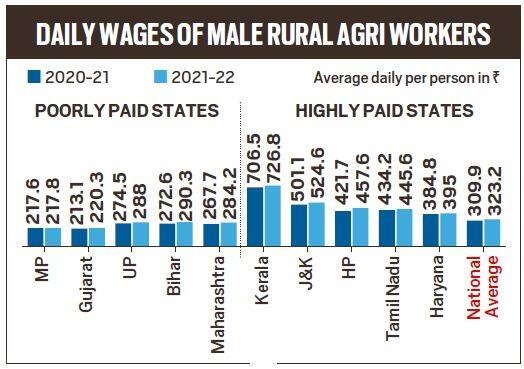Indian Economy
Rural Daily Wages
- 24 Nov 2022
- 6 min read
For Prelims: Reserve Bank of India, Rural Wages, Deen Dayal Upadhayay Grameen Kaushalya Yojana, Pradhan Mantri Kaushal Vikas Yojana, Pradhan Mantri Matru Vandana Yojana
For Mains: Government Policies & Interventions
Why in News?
Recently, the Reserve Bank of India (RBI) released data on daily wage payments in India.
What are the Findings?
- Agricultural Workers:
- In Madhya Pradesh (MP), male agricultural workers in rural areas got a daily wage of just Rs 217.8 while in Gujarat, it worked out to Rs 220.3 in the year ended March 2022.
- Daily wages in both the states are below the national average of Rs 323.2.
- Kerala leads in highly paid agricultural workers with an average wage of Rs 726.8 per worker.
- The high wages in Kerala have attracted farm workers from other poorly paid states with around 25 lakh migrant workers reportedly living in the state.
- In Jammu & Kashmir, farm workers get an average wage of Rs 524.6, Himachal Pradesh Rs 457.6, and Tamil Nadu Rs 445.6 per person.
- In Madhya Pradesh (MP), male agricultural workers in rural areas got a daily wage of just Rs 217.8 while in Gujarat, it worked out to Rs 220.3 in the year ended March 2022.
- Non-agricultural Workers:
- In the case of male non-agricultural workers, the lowest wage was in MP with an average wage of Rs 230.3 while Gujarat workers got a daily wage of Rs 252.5 and Tripura Rs 250 — all below the national average of Rs 326.6.
- Kerala again leads in non-agricultural workers’ wages with Rs 681.8 wage per person.
- Kerala was followed by J&K, Tamil Nadu and Haryana for the year ended March 2022.
- Gujarat and Madhya Pradesh are again below the national average of Rs 373.3 in the case of rural male construction workers.
- Gujarat rural construction workers got an average wage of Rs 295.9, MP Rs 266.7 and Tripura Rs 250.
- Construction Workers:
- Daily wage for rural construction workers was Rs 837.7 in Kerala, Rs 519.8 in J&K, Rs 478.6 in Tamil Nadu and Rs 462.7 in Himachal Pradesh.
What are the Issues associated with Rural Wages?
- Rural jobs are dependent on agriculture which in turn is influenced by monsoon and rabi and kharif production.
- Low agricultural prices contribute to lower incomes in rural areas.
- Most new jobs in the rural areas are for unskilled workers, so the wages and nature of the work are unattractive.
- There is a strong gender disparity, where the female worker is paid only 70% of what the male worker earns.
- Productivity increases without wage increases could offset the impact of real wage increases on welfare.
What are the Related Initiatives?
- Deen Dayal Upadhayay Grameen Kaushalya Yojana
- Pradhan Mantri Kaushal Vikas Yojana
- Mahatma Gandhi National Rural Employment Guarantee Act
- National Rural Livelihood Mission
- Pradhan Mantri Awas Yojana
Way Forward
- To tackle the challenge of creating decent jobs for its growing young population, action will be needed on multiple fronts including investments in human capital, revival of the productive sectors, and programmes to stimulate small entrepreneurship.
- There must be incentives provided to rural food processing industries, and value chains must be efficient in linking processing with transportation.
- In addition, contract farming and direct farm-factory connections offer considerable potential for rural income security.
- Digitalisation in rural space and Local e-governance will be critical to making 650,000 villages and 800 million citizens self-sufficient.
- Through active collaboration between the public and private sectors, a rural knowledge platform can be built that will bring cutting-edge technology deeper into villages and create jobs.
- Artificial Intelligence can be used to facilitate smart and precise agriculture.
UPSC Civil Services Examination, Previous Year Question (PYQ)
Q. Among the following who are eligible to benefit from the “Mahatma Gandhi National Rural Employment Guarantee Act”? (2011)
(a) Adult members of only the scheduled caste and scheduled tribe households
(b) Adult members of below poverty line (BPL) households
(c) Adult members of households of all backward communities
(d) Adult members of any household
Ans: (d)
Exp:
- Mahatma Gandhi National Rural Employment Guarantee (MGNREGA), which is the largest work guarantee programme in the world, was enacted in 2005 with the primary objective of guaranteeing 100 days of wage employment per year to every household whose adult members volunteer to do unskilled manual work.
- It aims at addressing the causes of chronic poverty through the ‘works’ (projects) that are undertaken, and thus ensuring sustainable development. There is also an emphasis on strengthening the process of decentralisation by giving a significant role to Panchayati Raj Institutions (PRIs) in planning and implementing these works.
- Therefore, option D is the correct answer.







